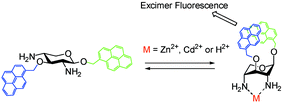A tong-like fluorescence sensor for metal ions: perfect conformational switch of hinge sugar by pyrene stacking†
Abstract

* Corresponding authors
a
Department of Life Science, Graduate School of Bioscience and Biotechnology, Tokyo Institute of Technology, 4259 B3 Nagatsutacho, Midoriku, Yokohama, Japan
E-mail:
hyuasa@bio.titech.ac.jp

 Please wait while we load your content...
Something went wrong. Try again?
Please wait while we load your content...
Something went wrong. Try again?
H. Yuasa, N. Miyagawa, M. Nakatani, M. Izumi and H. Hashimoto, Org. Biomol. Chem., 2004, 2, 3548 DOI: 10.1039/B411344F
To request permission to reproduce material from this article, please go to the Copyright Clearance Center request page.
If you are an author contributing to an RSC publication, you do not need to request permission provided correct acknowledgement is given.
If you are the author of this article, you do not need to request permission to reproduce figures and diagrams provided correct acknowledgement is given. If you want to reproduce the whole article in a third-party publication (excluding your thesis/dissertation for which permission is not required) please go to the Copyright Clearance Center request page.
Read more about how to correctly acknowledge RSC content.
 Fetching data from CrossRef.
Fetching data from CrossRef.
This may take some time to load.
Loading related content
